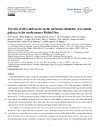Identificador persistente para citar o vincular este elemento:
https://accedacris.ulpgc.es/jspui/handle/10553/114310
| Título: | The role of tides and sea ice on the carbonate chemistry in a coastal polynya in the south-eastern Weddell Sea | Autores/as: | Droste, Elise Sayana Hoppema, Mario González Dávila, Melchor Santana Casiano, Juana Magdalena Queste, Bastien Y. Dall'Olmo, Giorgio Venables, Hugh J. Rohardt, Gerd Ossebaar, Sharyn Schuller, Daniel Trace-Kleeberg, Sunke Bakker, Dorothee C. E. |
Fecha de publicación: | 2022 | Proyectos: | CARBOCHANGE (264879) EU FP7 | Publicación seriada: | Ocean Science | Resumen: | Tides significantly affect polar coastlines by modulating ice shelf melt and modifying shelf water properties through transport and mixing. However, the effect of tides on the marine carbonate chemistry in such regions, especially around Antarctica, remains largely unexplored. We address this topic with two case studies in a coastal polynya in the south-eastern Weddell Sea, neighbouring the Ekström Ice Shelf. The case studies were conducted in January 2015 (PS89) and January 2019 (PS117), capturing semi-diurnal oscillations in the water column. These are pronounced in both physical and biogeochemical variables for PS89. During rising tide, advection of sea ice melt water from the north-east created a fresher, warmer, more deeply mixed water column with lower dissolved inorganic carbon (DIC) and total alkalinity (TA) content. During ebbing tide, water from underneath the ice shelf decreased the polynya's temperature, increased the DIC and TA content, and created a more stratified water column. The variability during the PS117 case study was much smaller, as it had less sea ice melt water input during rising tide and was better mixed with sub-ice shelf water. The contrasts in the variability between the two case studies could be wind and sea ice driven, and underline the complexity and highly dynamic nature of the system. The variability in the polynya induced by the tides results in an air-sea CO2 flux that can range between a strong sink (-20 mmol m-2 day-1) and a small source (7 mmol m-2 day-1) on a semi-diurnal time scale. If the variability induced by tides is not taken into account, there is a potential risk of overestimating the polynya's CO2 uptake by 98 % or underestimating it by 108 % (mistaking it for a source instead of a variable sink), compared to the average flux determined over several days. Given the disproportionate influence of polynyas on heat and carbon exchange in polar oceans, we recommend that future studies around the Antarctic and Arctic coastlines consider the timing of tidal currents in their sampling strategies and analyses. This will help constrain variability in oceanographic measurements and avoid potential biases in our understanding of these highly complex systems. | URI: | https://accedacris.ulpgc.es/handle/10553/114310 | ISSN: | 1812-0792 | DOI: | 10.5194/os-2022-19 | Fuente: | Ocean Science [ISSN 1812-0792], Abril 2022 |
| Colección: | Artículo preliminar |
Visitas
81
actualizado el 09-mar-2024
Descargas
26
actualizado el 09-mar-2024
Google ScholarTM
Verifica
Altmetric
Comparte
Exporta metadatos
Los elementos en ULPGC accedaCRIS están protegidos por derechos de autor con todos los derechos reservados, a menos que se indique lo contrario.
